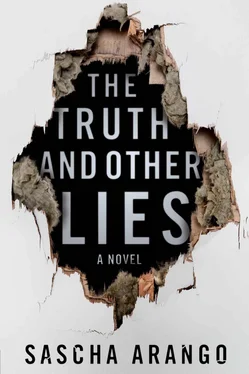Betty passed through the open gate at a crawl and followed the concrete slabs that were overgrown with weeds. Heaps of windblown rubbish were piled up. Yellow and blue plastic drums rolled around in the wind. A putrid smell hung over everything. Betty let the car roll up to a waist-high wall, where a sign in faded paint read NO ACCESS. She stopped the car, got out, and looked around her.
“Follow the arrows,” chirped the GPS.
The terrace was bathed in red evening light. More guests had sat down. A woman was just being led past Henry’s table. He followed her tanned ankles in their backless heels. Henry’s phone buzzed.
“Betty, where are you?”
“I’ve ended up in a rubbish dump and there’s a ‘No Access’ sign in front of me. Is this supposed to be a joke? There’s no restaurant here.”
“Then you’re standing in front of a wall, right?”
“Yes, and I’m not driving any further. It’s really spooky here.”
Henry laughed. “Just ignore the sign. Keep driving a bit. I’ll come to meet you.”
His laughter reassured her. After a brief hesitation Betty got back in the car and drove slowly along the ugly wall. She kept the phone at her ear. She could hear his steady breathing. After a hundred feet the countryside opened out on her left and the sea came into view.
“OK, I’m right by the water now. There’s a hangar here. There are dustbins and old rail tracks all over the place. No one in sight, no car. Where are you?”
“On my way to you. Stop next to the hangar. I’ll be there in a second.”
Betty stopped the car next to the hangar; its enormous door stood open like the jaws of a crocodile. The dust on the windows reflected the light so brightly that she couldn’t make out what might be hidden in the darkness within.
“The restaurant’s not in there , is it?”
“I can see you, Betty. Get out, turn around, can you see me?”
Betty opened the car door and got out. A cold wind blew out of the darkness of the hangar. She clutched the phone in her fist and peered around.
“Henry, where are you?”
Jenssen liked statistics. Like most of his colleagues he was of course acquainted with the annual crime stats. Numbers tell stories. Especially if you compare them with one another — for instance, the fact that in Germany in 2009 precisely 38,117 women underwent facial laser treatment compared with 42,623 German men over the same period of time. “What does that tell us?” Jenssen liked to ask whenever he cited such figures in the police headquarters’ canteen.
Homicide offenses, counting both murder and manslaughter, had gone down by 2.2 percent compared with the previous year. The rate of solving crimes had now reached 95.9 percent, which throws a good light on the investigative work of the authorities and a bad light on the acumen of your average perpetrator of violence. It would seem that the almost one hundred percent likelihood of being convicted of murder and severely punished is regarded by most offenders as acceptable. Maybe for the simple reason that it’s only almost one hundred percent , and because the statistics don’t affect them personally — just the others. And not least because crime statistics provide information about detected murders, while the undetected ones, not to say the successful ones, remain in the paradise of darkness. Thus it can be assumed with a kind of foreboding that the coming years will see a similar percentage of murders committed and punished.
Martha Hayden’s death by drowning had for Jenssen been a classic case of death by misadventure, because there was no motive or evidence pointing to anything else. The bike on the beach convinced him. It had convinced everyone. And yet “fatal swimming accident” was only a hypothesis, based solely on the discovery of the bicycle — a discovery made by her husband of all people. Purely hypothetically, the bike on the beach allowed the conclusion that the owner had been kidnapped by aliens and was now having a whale of a time with underage exomorphs on board their spaceship. Why not?
The disappearance of Bettina Hansen, a thirty-four-year-old editor at Moreany Publishing House, however, was no accident. It certainly wasn’t suicide either. A coast guard helicopter had sighted the burning car wreck at about 10:00 p.m. on a routine nightly flight. By the time the fire department had arrived forty-five minutes later, they could only smother the glowing plastic car parts with foam. This foam destroyed valuable evidence in the immediate vicinity of the wrecked car. The arson squad did not find the remains of a human body.
An hour after the beginning of the early shift, Jenssen arrived on the site of the derelict fish factory. It had been out of use for a decade and made him think of an apocalyptic seaside resort on the Costa Brava. Every muscle in his body was aching because he’d tried to catch up on three weeks of missed training in the gym the evening before. In spite of 1,500 milligrams of ibuprofen he couldn’t walk properly. He could only waddle sideways, his arms dangling like an orangutan’s.
The powder-fine white dust had turned into gray mush in the extinguishing foam around the car. Jenssen’s colleagues from the forensic unit were crawling around in it, looking for a trace of blood or hair, for vestiges of body fat or bone ash. Jenssen blessed his farsightedness in deciding at the beginning of his career not to work in forensics. Not because he found the work dull or pointless — no, the tedious thing was that the clues tended to be microscopic. You found a hair and it assumed the dimensions of a tree trunk. For Jenssen, poking around in the nanosphere like that took away the sensuous pleasures of detection.
Jenssen paced out the distance to the sea, counting forty-two steps. Abandoned rail tracks led down a slightly sloping concrete road into the water, where the skeletons of old freight cars had been left to rust — cars that had once been used to haul cargo from the cutters up onto land, in the good old days when there were still fish.
After a fruitless search the tracker dogs were loaded back into the van. A few police officers were still snorkeling in the reinforced shore area. Naval divers had been sent for and were expected in the course of the afternoon. They wouldn’t find anything either, Jenssen was convinced of that. He sat down on the tire of a heavy goods vehicle that had already received forensic treatment, and did some surreptitious stretching exercises to regain control of his upper arms. He was sure they would find neither a corpse, nor evidence of the perpetrators, nor indeed anything that might help solve the crime. Once again he took out the crumpled-up fax paper from his pocket and read the transcript of the emergency call.
At 9:16 p.m. Henry Hayden had dialed the emergency number of the police on his phone. First he had asked whether a road accident had been reported. Then Hayden had related that Bettina Hansen, an editor from his publishing house, had not turned up at their arranged meeting place with the original manuscript of his latest novel. He said that she had called him twice on her way there. Once to ask the way, a second time to tell him she’d be late. He’d been trying to call her for hours, but it hadn’t been possible to get hold of her. The dispatcher on the emergency services line told Henry that no one had reported an accident and that it was still too early for a missing-person search. Entirely correct procedure. Jenssen was sure that an examination of the phone company’s records would confirm Hayden’s statements as to length of call and location.
——
It was the proliferation of similarities that he found so remarkable. Two women had gone missing in less than a month — both of them closely connected with Hayden. One of them he was married to, the other he worked with. But, Jenssen wondered, wouldn’t everyone have called the police in this situation? Also striking was the fact that both women had disappeared altogether — not a single trace, not a hair, not a particle to be found. Martha Hayden was a practiced swimmer. Her death was plausible. No one can get the better of a strong current. But how could a healthy, sensible woman like this editor manage to get quite so lost? It was three miles of cratered, dusty road from the coastal road to here. No sign, no signpost, and no GPS entry indicated a restaurant in this wilderness. And what had happened to her corpse?
Читать дальше











